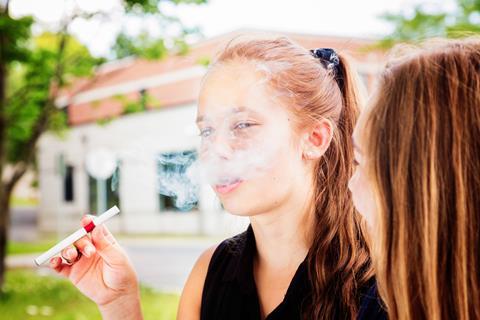[ad_1]
The government’s new mission is to “stop kids getting hooked on vaping”, health minister Neil O’Brien announced this month. “If your business plan relies on getting kids hooked on nicotine, we are coming for you,” he warned.
And youth use is indeed booming. Recent NHS Digital data shows a doubling of regular vape use for 11 to 15-year-olds between 2018 and 2021, while a 2022 ASH survey found 15.8% of 11 to 17-year-olds had tried vaping and 7% were current users.
The clampdown is two-pronged. First, £3m for a Trading Standards-led ‘enforcement squad’ to stop vapes being sold to youngsters. Second, an industry call for evidence to help find ways to reduce vaping’s appeal to teens.
But will the moves have an impact on underage use?
Enforcement
During test purchasing undertaken by Trading Standards in March last year at 32 retailers, 44% sold a device to an underage volunteer. Such sales were the most pressing ‘high street threat’ among officers, a January CTSI survey found.
But for under-resourced local Trading Standards teams, the £3m won’t only be spent on tackling underage sales. It will also fund testing products for non-compliance – costing around £200 per device with additional costs for safe disposal, regulatory guidance packs and more. intelligence sharing, border checks and national surveys..
In any event, enforcement is futile without more severe punishments, argue many in the sector. The UK Vaping Industry Association (UKVIA) wants retailer fines increased to £10,000 per instance of underage selling, plus a retailer registration scheme. Neil Mclaren, co-CEO of Vaping.com, wants £15,000 fines at a minimum, plus “a long stay at His Majesty’s pleasure will make the rest of them think twice”.
With tougher consequences, “the number of young people experimenting would dwindle rapidly, and the smokers who need vapes to stay off cigarettes would be more confident in the sector”, Mclaren says.

Flavours
The government has asked industry for views and data on the appeal of certain flavours to children, with some evidence already to hand. A 2021 PHE-funded analysis found fruit and sweet flavour categories were particularly popular among young people, as were “flavours with names mimicking alcoholic drinks”.
But one issue with any ban is that such flavours also appeal to adults. In a UKVIA poll of 2,000 adult vapers, 83% said flavoured vapes “help them pack in their smoking habits”.
The UKVIA would welcome bans on flavours “reminiscent of confectionery”, but association director general John Dunne also warns: “Having a ban on flavours could have a negative impact on smokers who are attempting to quit.”.
“Often with these types of policies trying to stamp out one problem can cause another,” he says
Another UKVIA survey suggests one in three vapers would go back to conventional cigarettes if flavours were banned.
Plain packaging
The UK was a fast follower of Australia’s pioneering ban on branded packaging for cigarettes. Could it act first on a similar policy for vapes?
The UKVIA says restrictions “should not go as far” because it would “just put vaping in the same bracket as smoking”. Cartoons and imitations of youth focused brands should be a no no however, it says.
But a March study by King’s College London suggests it could be effective. Researchers showed three types of packaging to teenagers and adults: plain white boxes, plain green boxes and branded packs.
Read more:
“Removing brand imagery from packs reduced appeal of vapes to teenagers without reducing appeal to adults,” says the study’s senior author Dr Katherine East. “This is a vital difference, as it means that vapes can still appeal to adults as a tool to stop smoking.”
Vape displays in stores – currently without restriction – could also be restricted limited.
David Fothergill, chairman of the Local Government Association’s community wellbeing board, says: “Vapes need to be out of sight and out of reach of children in the same way as cigarettes.”
“It is not right that stores are able to prominently display vaping paraphernalia for all to see, such as in a shop window,” he adds
Price
Disposable vapes, costing around a fiver, “A key factor in the popularity of vapes among young people is their low price – particularly when compared to cigarettes.
“Children who vape mainly use cheap disposables, which can be bought for under a fiver. They could easily be made less affordable” to youngsters, says Deborah Arnott, CEO of health charity ASH.
ASH has called for an excise tax of £4 per disposable, to reduce underage vaping “in one simple step”. Meanwhile, the UKVIA has long campaigned against any additional taxes on vaping products, lest they put people off the effective smoking cessation tool
But the UKVIA argues that could put off quitting smokers.
With any new measures, a delicate balance will need to be struck. Put youths off the product, but not deter adult smokers to try them. As Dunne puts it: “Trying to stamp out one problem can cause another. Vaping is effectively a double-edged sword.”
[ad_2]
Source link
